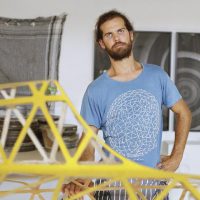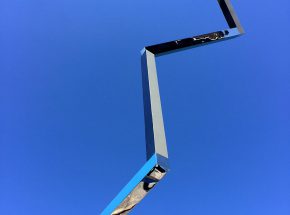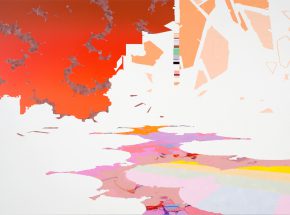

This series of works looks at the automobile in relation to a novel by J.G. Ballard entitled Concrete Island. It is the tale of a successful 35 year old architect in London who crashes his car between the embankments of two converging freeways, one southbound, the other eastbound, and the three-lane feeder road which threads its way up to the freeway. What ensues is a modern take on Robinson Crusoe; a tale of being marooned and trapped on an island from which there is no escape. The protagonist is forced to come to terms with this derelict traffic island as he grapples with the modernity and velocity, which have brought him there. His coveted Jaguar is slowly disassembled and parted out to create tools for his survival and attempted escapes from his predicament. The water reservoir for the windshield wipers is used for collecting water, burnt spark plugs are used to write messages on the concrete caissons, and sheet metal panels and doors are used as walls for his pavilion.
The novel deals with the subtleties of geography, architecture, and isolation. It is in this state of economy or necessity that the vehicle or craft is seen not for travel and velocity, but as material to be used. The work in this series transforms various parts of automobile to construct architectural models, and other objects for survival. Civic is a geodesic dome that is made from the original hood of a 1978 Honda Civic.
A set of eight silver gelatin prints spells the word “COMMUNIS”, which translates to ‘common’ or ‘public domain’, and is inspired by an ornamental African plant Ricinus Communis that has taken up root in the desolate spaces around the Los Angeles freeway system. These darkroom photograms take various parts of the car and transform them into letters which are overlaid on images of derelict foliage and plants found on freeway islands around Los Angeles. The exotic has become ordinary and the traffic island is a faraway land. In life, time changes and shifts as do distances… what one day seems mundane, on another can feel extraordinary.
“It is interesting, if not useful, to consider where one would go in Los Angeles to have an effective revolution of the Latin American sort. Presumably, that place would be in the heart of the city. If one took over some public square, some urban open space in Los Angeles, who would know? A march on City Hall would be inconclusive. The heart of the city would have to be sought elsewhere… The only hope would seem to be to take over the freeways.”
Charles M. Moore, Dean of the Yale School of Architecture
Jed Lind is a sculptor and installation artist currently based in Los Angeles. He has exhibited widely since receiving his Master of Fine Arts degree at the California Institute of the Arts in 2004.
Website
http://www.jedlind.com/

